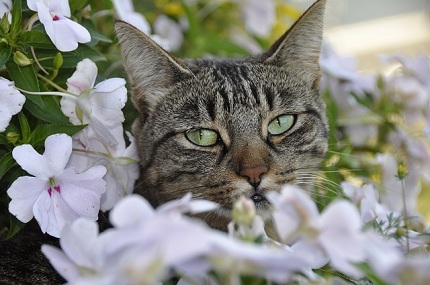Cats and Spring
Cats and Spring
After the cold winter days and short periods of daylight, cats become more active and interested in events in their surroundings in the spring. Cats spent more than three months in a state almost like hibernation, when they mostly slept on a sofa completely unaware what is going on around them. Feline experts claim that cats in the wild are also inactive during winter, and show the highest level of activity during the spring and summer. According to them, hormones are the main factor that moves them into action and drives them to hunt and mate. Domestic cats, which is not spayed or neutered, also show the similar pattern of behavior, while spayed, and neutered cats do that, but in a lesser degree. For majority cat owners, spring months bring various issues that can be very annoying. Namely, fleas, ticks and parasites explode in the spring and need special precautions to stamp them out. Furthermore, cats shed more in spring because they need a lighter coat in summer. To keep our cat happy and healthy, we need to keep cat’s bad and its environment fresh and clean. Feline experts recommend to vacuum our house daily and groom a cat regularly. To find out more about the pesky things that flourish in the spring and how to get rid of them, the article “Caring for Your Cat This Spring” gives us the following tips.
Cats and Spring
As cats return to exploring in the garden, lawn fertilizers and other pesticides can be a real danger. Keen gardeners must remember that lawn fertilizers and other pesticides can be very appealing but also highly toxic to pets.
After applying these chemicals make sure you follow the manufacturers’ instructions on how long to wait before allowing your pet into the area.
Animals of all kinds like to chew on plants. Fortunately most grasses are non-toxic but many garden plants can be dangerous to your cat.
Common plants that are poisonous to cats include Lillies, Pointsettias, tulips, lily of the valley and azaeleas.
Pets suffer from seasonal allergies, just like humans. Constant paw licking, body rubbing, excessive scratching, hair loss, skin rashes, and a “flaky” or “greasy” feeling coat may be a sign that your cat is suffering from allergies.
Many cats also go through several changes during the spring months. Namely, a lot of cats wake up earlier than in winter. Because of such annoying cat behavior for the majority of cat owners, feline experts suggest playing with a cat in the evening until it gets worn out. They tend to be hyperactive in the spring, and if we want to sleep peacefully at night, we need to spend some time playing, especially if the cat is the indoors. In the case of outdoor cats, we might not need to play with our cat every day, but we should supervise the area around the house to keep it safe. Sometimes we need to reconsider the plants in the yard and determine which one are potentially hazardous for the cat. When we undertake all necessary precautions regarding the potential problems for our cat, we can relax and enjoy the beauty of this most colorful season.











good too hear but all 3 of my are all in door cats they last longer too much wild life etc stevo